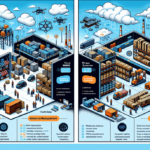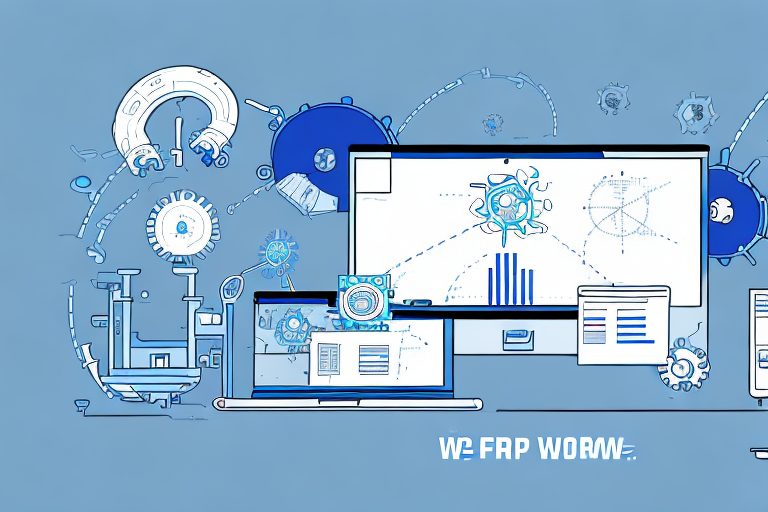Introduction to Warehouse Management Systems (WMS)
Warehouse management has become a critical component for businesses today. Efficiently managing storage, inventory, and distribution processes is essential for maintaining competitiveness. Warehouse Management Systems (WMS) have gained popularity as companies seek to streamline their operations, enhance efficiency, and reduce costs. This article delves into two leading solutions in the market: Oracle Warehouse Management Cloud (WMS) and SAP Extended Warehouse Management (EWM). We will compare these systems based on features, implementation, pricing, customer success stories, and future developments.
Oracle Warehouse Management Cloud (WMS)
Oracle's WMS is a comprehensive cloud-based solution designed to optimize warehouse operations. It offers end-to-end supply chain functionality, real-time inventory management, and user-friendly workflows to enhance efficiency. Key features of Oracle WMS include:
- Receiving and put-away
- Inventory management
- Picking, packing, and shipping
- Courier integration and returns management
Oracle WMS is known for its seamless integration with other Oracle Cloud solutions such as Transportation Management Cloud and Global Trade Management Cloud. This integration facilitates a smooth flow of information across the entire supply chain, from order placement to delivery. Additionally, Oracle WMS offers advanced analytics and reporting capabilities, enabling data-driven decision-making.
The platform's flexibility and scalability make it suitable for various industries and business sizes. As a cloud-based solution, Oracle WMS benefits from easy deployment, automatic updates, and lower IT costs compared to traditional on-premise systems.
Key Features of Oracle WMS
- Real-time Inventory Management: Provides up-to-the-minute inventory levels, reducing the risk of stockouts and overstocking.
- Efficient Warehouse Workflows: Streamlines processes such as receiving, picking, and shipping to enhance operational efficiency.
- Advanced Reporting and Analytics: Offers insights into warehouse performance, helping businesses make informed decisions.
- Seamless Integration: Connects with other Oracle applications like ERP and Supply Chain Management for unified business operations.
- Support for Multiple Warehouse Types: Suitable for distribution centers, manufacturing facilities, and retail stores.
SAP Extended Warehouse Management (EWM)
SAP's EWM is an advanced warehouse management solution that offers comprehensive support for managing complex logistics processes. It integrates seamlessly with other SAP modules, providing a holistic approach to supply chain management. Key features of SAP EWM include:
- Inventory management
- Put-away and storage bin control
- Replenishment control
- Picking and packing
- Supply chain optimization
- Yard logistics and labor management
One of the standout features of SAP EWM is its ability to provide real-time visibility into warehouse operations. This allows managers to monitor inventory levels, track order statuses, and identify potential bottlenecks. The system's advanced analytics and reporting capabilities support data-driven decision-making, enhancing overall supply chain efficiency.
SAP EWM is highly customizable, making it ideal for large organizations with complex warehouse operations. It supports integration with other SAP modules such as SAP ERP and SAP Supply Chain Management, ensuring a unified and efficient workflow across all business processes.
Key Features of SAP EWM
- Centralized Inventory Visibility: Offers comprehensive control and visibility over inventory across multiple locations.
- Advanced Labor Management: Optimizes workforce allocation and improves productivity.
- Dynamic Pick, Pack, and Put-away Strategies: Enhances order fulfillment accuracy and speed.
- Quality Management and Hazardous Materials Handling: Ensures compliance with safety standards and quality control.
- Real-time Monitoring and Reporting: Facilitates proactive problem-solving and efficient warehouse operations.
Feature Comparison: Oracle WMS vs SAP EWM
Both Oracle WMS and SAP EWM offer robust warehouse management functionalities, but they cater to different business needs:
- Functionality: Oracle WMS covers essential warehouse operations, making it suitable for small to medium-sized warehouses. In contrast, SAP EWM provides in-depth functionality geared towards larger, more complex operations.
- Customization: Oracle WMS offers a user-friendly customization process, whereas SAP EWM requires more technical expertise, making it better suited for organizations with specific customization needs.
- Scalability: Both systems are scalable, but SAP EWM is particularly adept at handling extensive supply chain scenarios and larger warehouse setups.
When choosing between the two, businesses should consider their specific operational requirements, technical capabilities, and budget constraints.
Deployment and Implementation
Oracle WMS Deployment
Oracle WMS is a cloud-based solution available through a subscription model. Its cloud-native architecture allows for faster deployment, typically within 100 days. The implementation process is streamlined, enabling businesses to start leveraging the system's capabilities quickly.
SAP EWM Deployment
SAP EWM offers both on-premise and cloud-based deployment options, providing flexibility to meet diverse business needs. However, the implementation of SAP EWM is more complex and time-consuming, often requiring expert-level configuration and professional consultation. Larger organizations may need to allocate more resources and time to ensure a successful deployment.
Pricing Models
Oracle WMS Pricing
Oracle WMS operates on a subscription-based pricing model, making it cost-effective for small to medium-sized businesses. Pricing is typically based on the number of users, with additional costs for Oracle cloud infrastructure and storage. This model allows businesses to scale their usage as needed without significant upfront investments.
SAP EWM Pricing
SAP EWM offers a combination of on-premise and cloud-based pricing options. Costs vary depending on the deployment mode and the extent of customization required. Generally, SAP EWM is more expensive than Oracle WMS, making it a better fit for larger organizations with complex warehouse operations and the budget to support higher implementation and maintenance costs.
Customer Success Stories
Oracle WMS Success Stories
Textron implemented Oracle WMS and achieved an impressive 99.99% inventory accuracy and a 25% increase in productivity, significantly enhancing their business operations.
Rogers Communications leveraged Oracle WMS to streamline their warehouse processes, resulting in millions of dollars in savings and improved operational efficiency.
SAP EWM Success Stories
Benteler, a global steel supplier, reduced labor requirements by 20% and enhanced supply chain efficiency using SAP EWM.
Al-Futtaim Logistics, a leading logistics provider in the United Arab Emirates, improved inventory accuracy from 60% to 97% and boosted productivity by approximately 15% after implementing SAP EWM.
Integration Capabilities
Oracle WMS Integration
Oracle WMS integrates seamlessly with other Oracle software products, including Oracle Supply Chain Management (SCM), Transportation Management, and Global Trade Management. This ensures efficient data flow and coordination across various business functions, enhancing overall operational efficiency.
SAP EWM Integration
SAP EWM offers comprehensive integration with other SAP modules such as SAP ERP and SAP Supply Chain Management. This unified approach allows organizations to manage diverse business processes seamlessly, improving efficiency and accuracy.
Future Roadmaps
Oracle WMS Future Developments
Oracle's roadmap for WMS includes enhancing the platform's mobility, increasing AI-enabled automation, optimizing returns management, and expanding global trade management functionalities. These advancements aim to provide users with more innovative tools to manage their warehouse operations efficiently.
SAP EWM Future Developments
SAP EWM plans to simplify system usage and boost scalability. The company is also integrating cutting-edge technologies such as the Internet of Things (IoT), machine learning, and artificial intelligence to enhance the software's capabilities, offering users more innovative options for warehouse management.
Conclusion
Choosing the right Warehouse Management System (WMS) is pivotal for the success of your business operations. Both Oracle WMS and SAP EWM offer robust solutions tailored to different business sizes and requirements. Oracle WMS is ideal for small to medium-sized businesses seeking a cost-effective, cloud-based solution with essential functionalities. On the other hand, SAP EWM is better suited for larger organizations that require advanced features and the ability to handle complex warehouse operations. When selecting a WMS, consider factors such as feature set, scalability, integration capabilities, implementation complexity, and pricing to ensure the best fit for your business needs.




















